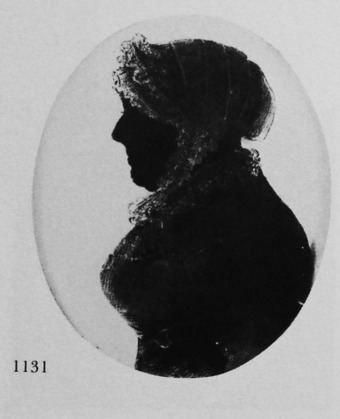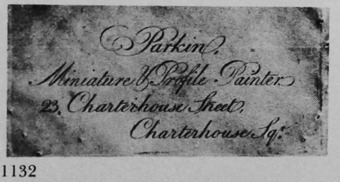Parkin (McKechnie Section 3)
See also Section Seven
Recorded by Mills as Parkin, Colchester' and by Jackson (The History of Silhouettes) as Paskin, Colchester'. I assume that both entries refer to Parkin; since both Parkin and Paskin' are stated to have worked in Colchester, it seems unlikely that two artists of such similar names should have been working in the same small town, and new material discovered later clearly gives the name Parkin.
The earliest record of work by Parkin is an advertisement in the Royal Cornwall Gazette (11 July 1807):
Mr. PARKIN
PROFILE AND MINIATURE PAINTER
Takes STRIKING LIKENESSES on plain or convex Glasses, or on Lockets. Time of sitting for a Profile only one minute — for Miniature, hall an hour.
Specimens may be seen at his lodgings, at Mr. BARNS's, in the Market-place Truro.
Ladies and Gentlemen waited on at their own houses.
Although here, and on two extant trade labels, Parkin refers to himself as a miniature painter, he is not recorded by Foskett, nor does Graves list any exhibits. Two silhouettes, formerly in the Wellesley collection, were painted in part colour, presumably on glass. It is not known on what surface Parkin painted miniatures, but his silhouettes appear to have been painted only on glass.
Parkin certainly worked in Colchester for long enough to justify the printing of a trade label (No. 1) bearing his Colchester address. This was listed by Jackson under Paskin, but I assume it to be a label of Parkin's. No. 2 (illustrated) bears the address 23 Charterhouse Street, Charterhouse Square; to judge from the appearance of the illustrated example backed with this label, Parkin was in London c. 1818. He was no doubt an itinerant artist, and it is impossible to state with certainty which label he used first.
As far as I can tell from the only silhouette by him which I have seen, Parkin worked in hatching against a base entirely made up of fingerprinting, with the exception of the face, which is shown in dead black. This work is most like that of James Pelham the younger (q.v.), although it is less dense in effect. The illustrated example, a profile of a woman, has no bust-line termination. The silhouette is backed with a wax filling. The piece has the appearance of being stippled (possibly the phrase 'in imitation of marble', on Trade Label No. 1, refers to this), although Parkin has not used this technique as finely as did Hinton Gibbs.
Since fingerprinting was used at this date to rep1
1
J
resent the transparent drapery of women's dresses which was so much in fashion, it is likely that coats worn by men at the time might have a denser appearance on any silhouettes of men by Parkin which might come to light.
According to the wording of Trade Label No. 1, jewellery pieces might be discovered. There is no specific mention of ivory on this label, and small glass profiles might be seen in lockets or bracelet settings.
Of the two known trade labels, No. 1 (listed by Jackson under Paskin') was used in Colchester (though we do not know when), No. 2 (illustrated) was used in London c. 1818. No. 1 reads as follows:
PARKIN
MINIATURE AND PROFILE PAINTER
Profiles painted in a new and elegant style producing the effect of aquatint engraving, with the beauty and softness of enamel in imitation of marble, conveying the most perfect Likeness.
In rings, brooches, lockets.
Time of sitting, One Minute.
Ladies and gentlemen attended in their own houses, if required, by leaving their address at Mr. Good's, 14, Head St., Colchester.
Ills. 1131, 1132

Unknown woman
Silhouette painted on convex glass against a heavily fingerprinted base; backed with wax
c. 1818
3 ¼ x 2 ¾ in./83 x 70mm.
Trade Label No. 2
Frame: papier mâché
M. A. H. Christie collection

Trade Label No. 2 of Parkin, from the silhouette illustrated in 1131.
M. A. H. Christie collection
